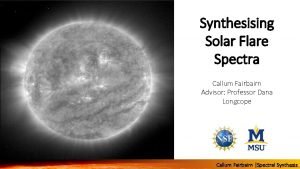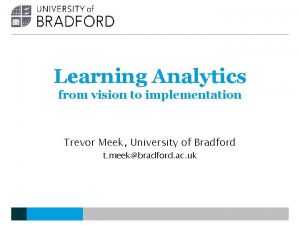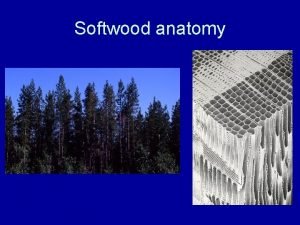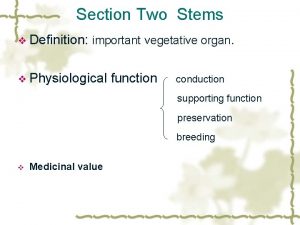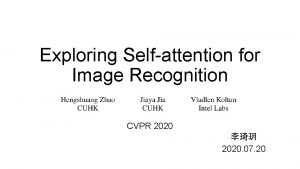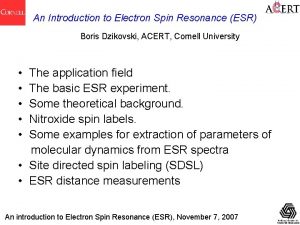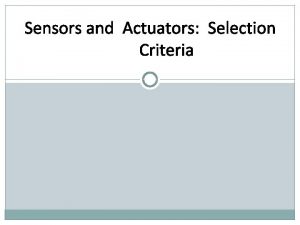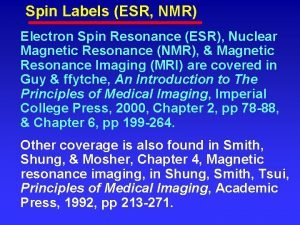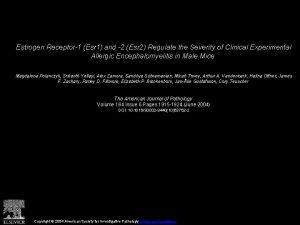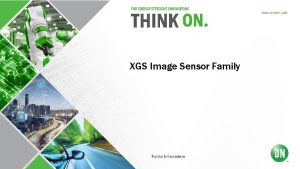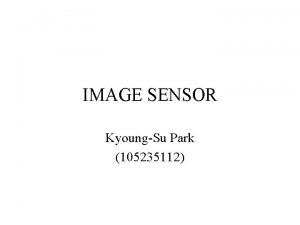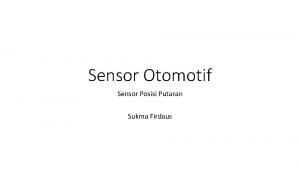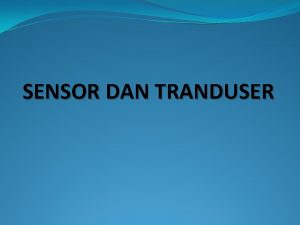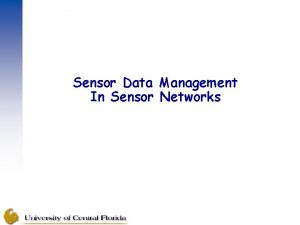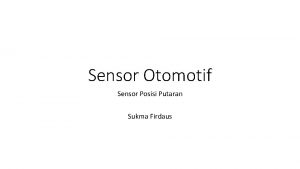Exploring Image Sensor Applications CALLUM WOOD ESR 7





















- Slides: 21

Exploring Image Sensor Applications CALLUM WOOD (ESR 7 -WP 5) ANDREA FERRETTI (ESR 13 -WP 5) EVGENIIA FILIPPOVA (ESR 16 -WP 6) STREAM WINTER SCHOOL 2017 WP 5 & WP 6

AGENDA Part 1: Motivation & Basics � Motivation � Description of image sensors and their operation. Part 2: Existing Applications � Electron Microscopy Detectors � Radiation Detectors Part 3: Future Applications Analysis � Finding new application areas: Technological Competence Leveraging � Conclusion and Open Discussion 1

Part 1: Motivation & Basics Part 2: Existing Applications Part 3: Future Applications EXPLORING NEW IMAGE SENSOR APPLICATIONS How do we see the invisible? Expanding the field-of-use of image sensor applications. � Presenting the fundamentals of image sensors and some existing applications. � Exploration of possible future applications. 2

Part 1: Motivation & Basics Part 2: Existing Applications Part 3: Future Applications HOW IMAGE SENSORS WORK Photodetector basics: 1. Photons can free electrons. 1. Electrons (-ve) and holes (+ve) drift in opposite directions in presence of electric field. 1. They collect at electrodes to generate a voltage signal. 1. Combining pixel signals together provides a 2 D image. Simple Solar Cell Source: http: //iamtechnical. com/solarcell 3

Part 1: Motivation & Basics Part 2: Existing Applications Part 3: Future Applications TYPES OF IMAGE SENSORS The most common devices are Charge Coupled Device (CCD) and CMOS: � Faster acquisition. � Higher sensitivity - better contrast and detectability. CCD: � Higher dynamic range. � Longer exposure required. 4

Part 1: Motivation & Basics Part 2: Existing Applications Part 3: Future Applications ELECTRON MICROSCOPY Optical microscopy resolution limited ( d = λ/2 NA ) due to lower wavelength boundary of visible light spectrum. Operation in a glance: � Electron emitters generate electron beam � E-field acceleration determines energy ( λ= h/P ) 5

Part 1: Motivation & Basics Part 2: Existing Applications Part 3: Future Applications ELECTRON MICROSCOPY Optical microscopy resolution limited ( d = λ/2 NA ) due to lower wavelength boundary of visible light spectrum. Operation in a glance: � Electron emitters generate electron beam � E-field acceleration determines energy ( λ= h/P ) � Magnetic coils collimate/position the beam 6

Part 1: Motivation & Basics Part 2: Existing Applications Part 3: Future Applications ELECTRON MICROSCOPY Optical microscopy resolution limited ( d = λ/2 NA ) due to lower wavelength boundary of visible light spectrum. Operation in a glance: � Electron emitters generate electron beam � E-field acceleration determines energy ( λ= h/P ) � Magnetic coils collimate/position the beam Particle-Sample Interaction: electrons may scatter in different directions � Scanning EM (SEM) exploits back-scatter � Transmission EM (TEM) exploits front-scatter TEMs are currently the leading device for achieved resolution. 7

Part 1: Motivation & Basics Part 2: Existing Applications Part 3: Future Applications ELECTRON MICROSCOPY FIELDS/TECHNIQUES TEM Modes: CTEM / STEM / Diffraction Different application fields: Life Science, Materials Science, Semiconductor Analysis. . Major latest EM outbreaks: �Electron counting technique enabled last resolution revolution - as opposing to normal charge integration mode. �Cryo-EM used to reduce Biological sample damage - it enabled 2017 chemical Nobel prize winning 8

Part 1: Motivation & Basics Part 2: Existing Applications Part 3: Future Applications DETECTORS FOR ELECTRON MICROSCOPY Detectors play a major role in this dramatic atomic resolution improvement. Optical analogy to human eye: detectors are sensitive to particles as human eye is to light, transforming incident particles into electric signals. Detection history in EM: 1. FILM: no live analysis 2. CCD: low frame-rate 3. CMOS: rolling shutter Different characteristics needed: � Diffraction -> high dynamic range � Life Science -> low noise, high sensitivity � Material Science -> radiation hardness 9

Part 1: Motivation & Basics Part 2: Existing Applications Part 3: Future Applications ENVIRONMENTAL RADIATION DETECTION Why? � Vital for health and safety. Areas: � Radioactive pollutants in water (drinking water, waste treatment, sea), underground (mining, drilling), agriculture (soil, across food-chain). 10

Part 1: Motivation & Basics Part 2: Existing Applications Part 3: Future Applications WHAT WE WANT TO DETECT � Alpha-particles and beta-particles. � Electromagnetic radiation (gamma rays, x-rays, ultraviolet, near-infrared). Alpha and Beta Decay Source: chem. libretexts. org, Introductory Chemistry (Tro). Electromagnetic Radiation Spectrum 11

Part 1: Motivation & Basics Part 2: Existing Applications Part 3: Future Applications IMAGE SENSORS FOR RADIATION DETECTORS Geiger-Müller: Gas-filled chamber with electrodes - no image sensor. ✘ Can only find count rate. Scintillator: Plastic/Crystal that absorbs radiation and emits light. ✔ Signal scales with energy of radiation. ✘ Multiple components - photomultiplier tube for detection. Solid-State (Image Sensor): ✔ Signal also scales with energy. ✔ Higher energy resolution than scintillator. ✔ Fewer components. 12

Part 1: Motivation & Basics Part 2: Existing Applications Part 3: Future Applications USING CMOS Many different technologies are already used for image sensors. Why use CMOS technology? � Radiation hard, monolithic sensors, smart sensor arrays. � Mass produced, commercial process - high availability. 13

Part 1: Motivation & Basics Part 2: Existing Applications Part 3: Future Applications ELECTRON MICROSCOPY & RADIATION DETECTORS - WHAT ELSE? ? ? ? Electron Microscopy ? ? ? Radiation Detectors ? 14

Part 1: Motivation & Basics Part 2: Existing Applications Part 3: Future Applications SEARCH FOR NEW APPLICATION FIELDS TO IMAGE SENSORS 1 Identification of technology benefits Analyzing the technology from the user’s perspective with a focus on: problem solved and benefits derived. 15

Part 1: Motivation & Basics Part 2: Existing Applications Part 3: Future Applications SEARCH FOR NEW APPLICATION FIELDS TO IMAGE SENSORS 1 Identification of technology benefits Analyzing the technology from the user’s perspective with a focus on: problem solved and benefits derived. 2 Search for application fields Search for similar problems the technology may solve and for persons who might benefit from the technology. 15

Part 1: Motivation & Basics Part 2: Existing Applications Part 3: Future Applications SEARCH FOR NEW APPLICATION FIELDS TO IMAGE SENSORS 1 Identification of technology benefits Analyzing the technology from the user’s perspective with a focus on: problem solved and benefits derived. 2 3 Analysis of application fields Rough assessment of the technology according to strategic fit and benefit relevance; further in-depth analysis of market and competitors. Search for application fields Search for similar problems the technology may solve and for persons who might benefit from the technology. 15

Part 1: Motivation & Basics Part 2: Existing Applications Part 3: Future Applications SEARCH FOR NEW APPLICATION FIELDS TO IMAGE SENSORS 1 Identification of technology benefits 3 Analyzing the technology from the user’s perspective with a focus on: problem solved and benefits derived. 2 Search for application fields Search for similar problems the technology may solve and for persons who might benefit from the technology. Analysis of application fields Rough assessment of the technology according to strategic fit and benefit relevance; further in-depth analysis of market and competitors. 4 Design of a business model Business model should answer the question: “how exactly should the company enter the market within a specific application area? ” 15

Part 1: Motivation & Basics Part 2: Existing Applications Part 3: Future Applications SOME USEFUL QUESTIONS TO ASSESS A MARKET ATTRACTIVITY OF AN APPLICATION FIELD ? How many benefits offered by the technology are relevant for this application field? ? How relevant is/will be the problem solved by the technology in this application area? ? Can this new market be served with existing resources of the company? ? Is it possible and reasonable to enter the market in the near future? ? Is it strategic important for the company to enter this market? ? Is the business model scalable? ? How the company will differ from the competitors (unique value proposition)? 16

Part 1: Motivation & Basics Part 2: Existing Applications Part 3: Future Applications CONCLUSION: ● Image sensors are in rapid expansion, especially CMOS devices. ● They play a fundamental role in many modern applications. CAN WE EXPLOIT THEM EVEN MORE? Time for questions and open discussion. 17
 Noughts and crosses callum
Noughts and crosses callum Callum fairbairn
Callum fairbairn Callum osborne-ward
Callum osborne-ward Callum meek
Callum meek Callum meek
Callum meek Aschoff nodules
Aschoff nodules Arthralgia
Arthralgia Dr michael dickinson
Dr michael dickinson Callum meek
Callum meek Cross field pits
Cross field pits Aerial stem modification examples
Aerial stem modification examples Gymnosperm structure
Gymnosperm structure Esau wood poem
Esau wood poem Wood wood teenager
Wood wood teenager Exploring self-attention for image recognition.
Exploring self-attention for image recognition. Esr 3269
Esr 3269 Anemia and esr
Anemia and esr Esr normal range in male
Esr normal range in male Corrected esr formula
Corrected esr formula Mch high
Mch high Hematocrit normal
Hematocrit normal Esr and nmr
Esr and nmr

